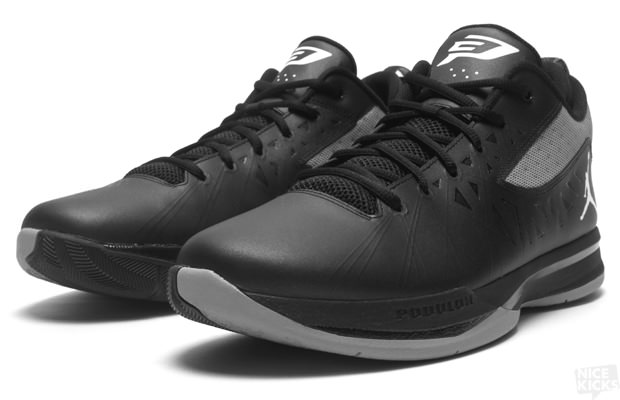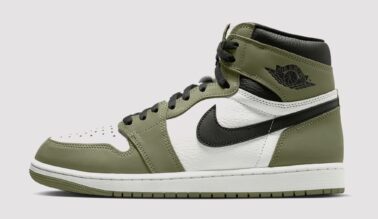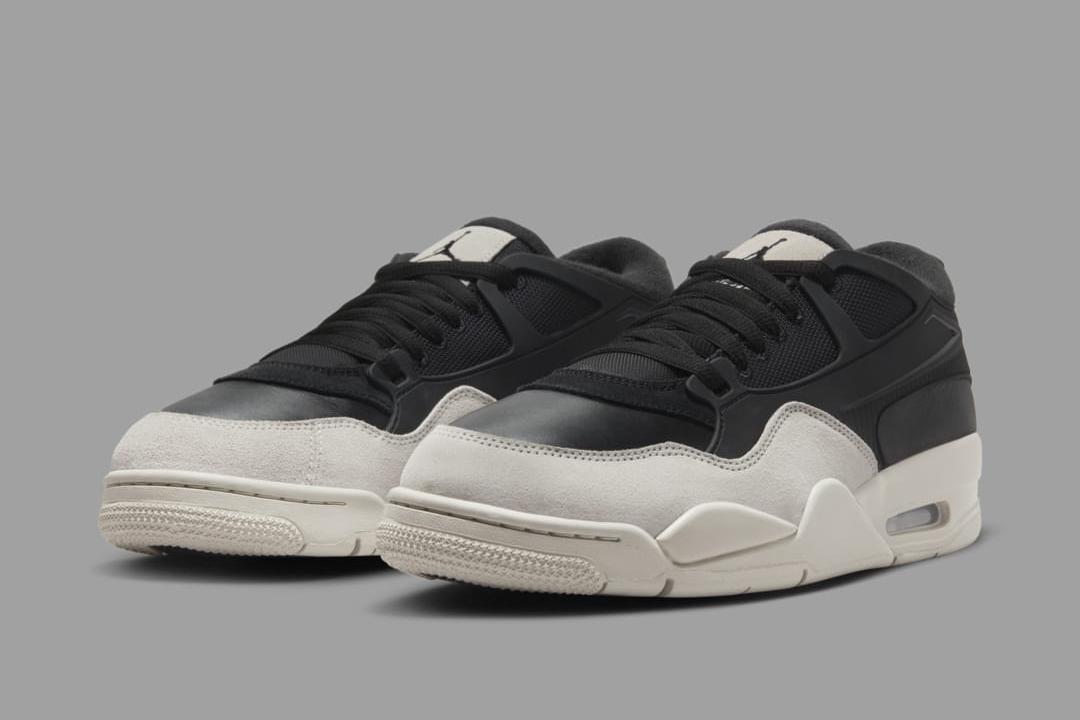This post may contain affiliate links. Please read our disclosure policy.
“Fly Around”, Jordan Brand’s third and final choice for flight, comes in the form of Chris Paul’s fifth signature model, the Jordan CP3.V. Unlike the super responsive Jordan Melo M8 and the Lunar-laced Jordan Fly Wade 2, the Jordan CP3.V focuses on quickness, speed and changing gears throughout a game. A combination of extremely lightweight Flywire (11.7 ounces), a low-to-the-ground feel and a sturdy Podulon cushioning are just a few of the characteristics incorporated on the CP3.V’s construction. Is the Jordan CP3.V one of the better low top performance basketball sneakers on the market? View our Jordan CP3.V performance review to find out.
RELATED: Inside the Numbers: 7 Symbolic Details on the Jordan CP3.V | Everybody Loves Chris: CP3?s 10 Best Kicks & Crossover Combinations | Jordan CP3.V Launch Event Recap
Cushioning: The Jordan CP3.V isn’t as bouncy and responsive as the Jordan Melo M8 and the Jordan Fly Wade 2, but then again it doesn’t have to be considering this shoe is engineered for a player that plays lower to the ground and relies on speed and quickness rather than elevation. Still, the CP3.V’s cushioning score is almost as high as the previous two sneakers. How so? The cushioning in this sneaker is superb too, but it is more of a firm, dense and protection-focused cushioning rather than a springy, pliable cushioning level that focuses on quick jumps. This doesn?t mean that the CP3.V is not responsive at all. The CP3.V does have a responsive section on the midsole, which happens to be my favorite attribute of the shoe, and one that players who rely on quickness will treasure. Specifically, Jordan Brand incorporated the ultra responsive and plush Cushlon material on the medial side of the midsole and a much firmer cushioning in the form of CMP (Compression Molded Phylon) on the lateral side for lateral stability. It may all seem like a bunch of science, but you have to play in this shoe to experience the difference. If you watch Chris Paul closely, he uses a killer first step to get to the basket, as do most cat-quick guards. The responsive Cushlon material on the medial side of the shoe enables you to launch off of the planted foot quicker into your first step. When making a quick move to the basket from the perimeter, I felt more explosive getting to the basket because of the softer cushioning on the medial side, a section of the midsole where you usually launch off in the process of beating a defender with your first step. Contrarily, the CMP on the lateral sides of the shoe kept the sides of my feet from jamming against the sidewall of the shoe when I made quick jolts to the basket and when sliding my feet laterally on defense.
Traction: People refer to Chris Paul as one of, if not the best point guard in the game because of his ability to increase the intensity level of his teammates, leadership skills and his ability to break down any opponent. Yet, what some people fail to give him credit for is his ability to change speeds instantly. Throughout the course of a game, Chris Paul rarely sprints/speed dribbles up the court. Instead, he usually jogs the length of the court while probing the defense and changes paces at the most inopportune times. Jordan Brand catered to Chris Paul’s uncanny ability to switch gears by providing the guard with a distinctive, multidirectional traction pattern that is denser and closely compacted in high-wear areas such as the heel. If you take a look at the outsole, you can see thicker areas of the traction pattern on the heel and forefoot. I played quicker in this shoe than in the Melo M8 and Fly Wade 2. Sure, a lot of that has to do with the 11.7 ounce-weight and the all-Flywire upper, but having a traction pattern that features flex grooves in all different directions, helped tremendously when changing speeds.
Lockdown: For an extremely, lightweight sneaker that plays fast and low to the ground, I expected the CP3.V to rank higher than most shoes in the lockdown category. Even when I laced it up tightly, the CP3.V just didn’t capture me lockdown-wise. It doesn’t feel saggy around my foot, but it’s just not as locked down as I expected. I will say the shoe is extremely flexible and seems to conform to your foot with each passing wear, so there is really no sliding of your foot. Overall, it’s not the worst lockdown system, but I have definitely seen better. Honestly, your foot not being so locked down is actually not a bad thing in the CP3.V because it has other attributes that kind of offset its lockdown shortcomings such as the extremely low-cut collar, which allows your foot and ankle to move more naturally than in the other two flights we tested.
Responsiveness: As mentioned in the cushioning write-up, the CP3.V is not as responsive as the Melo M8 and Fly Wade 2 by no means. The Lunar foam in the Fly Wade 2 is exceptionally springy, and the combination of Max Air and exposed Zoom Air in the Melo M8 made for an overall dynamic wear in the forefoot and heel. Other than the aforementioned Cushlon on the medial side of this shoe, I wouldn’t necessarily refer to this shoe as responsive; however, the Cushlon section alone gives this shoe a reasonable score in this area.
Support: Obviously, we have to touch on the all-Flywire upper incorporated on the Jordan CP3.V. Although you might think a super lightweight shoe comprised of Flywire might not be as supportive as other sneakers on the market, Chris Paul’s fifth signature shoe is actually very accommodating and extremely comfortable. As mentioned earlier, the CP3.V’s thin plastic frame of Flywire is very flexible, allowing your foot to be supported by an upper that actually mimics your foot shape over time. Also, the external TPU midfoot shank is very firm and dense; therefore it provides a nice, stable platform for the heel.
Breathability: After my time playing in the Jordan Fly Wade 2, a shoe that features an all-Fuse upper, the switch to the Flywire-laced Jordan CP3.V ultimately played a big factor in my score for Chris Paul’ shoe in this area (maybe if I played in this shoe before lacing the Fly Wade 2 up, it would’ve scored higher). By no means does the thin, plastic frame over the Flywire suffocate my foot while I’m playing, but it’s just not as ventilated and breathable as the Fuse on the Fly Wade 2. Aesthetically, the 61 triangles throughout the upper are a great tie-in to Chris Paul’s story (see Inside the Numbers: 7 Symbolic Details on the Jordan CP3.V), but maybe creating increased ventilation through those slits, or developing other perforations for air to seep through, would have caused the CP3.V to score higher in this category.
Durability: Is Flywire durable? That has been one of the questions asked over and over about the super, lightweight technology that was introduced in 2008. In the past, some Flywire sneakers that we’ve tested seemed to get weaker over time, but I haven’t had any major problems with the Jordan CP3.V so far. Yet, one thing I must mention is the CP3.V began to bunch up and show a little bit of wear and tear on the lateral side between the toe area and the side panels after a few wears. However, that is a section where most sneakers tend to primarily show wear and tear, so that’s not a big problem.
Overview: Jordan Brand continues to get lower and lighter with Chris Paul’s signature line, and the Jordan CP3.V is the lowest and lightest to date. The Podulon cushioning is carried over from previous Chris Paul signatures to the CP3.V and rightfully so. It?s extremely cushioned from a protection standpoint. The CP3.V’s combination of low-to-the-ground tooling, protection-focused cushioning, and multidirectional traction, makes this creation an ideal shoe for a quick-oriented player such as Chris Paul.
The Jordan CP3.V is now available at retailers for $120.




